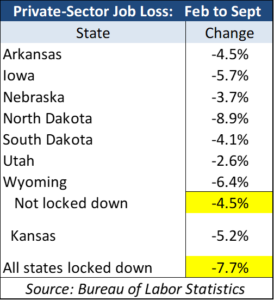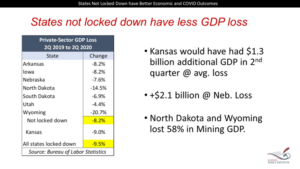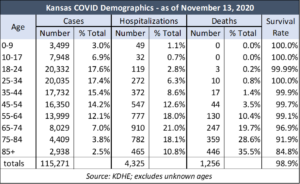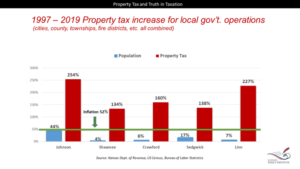Media bias comes in many flavors; making outright false claims, slipping editorial statements in news stories to push a political viewpoint, excluding relevant information to mislead readers, selectively using code words to undercut the validity of information, and making unfounded accusations are among the most common. The full menu was utilized in the coverage from the Kansas Reflector of the November 16 hearing of the Special Committee on Economic Recovery.
For background, the Kansas Reflector is a Topeka-based online news outlet that provides “daily coverage of state government and politics.” A web-based media outlet may sound similar to the Sentinel — owned by Kansas Policy Institute — but the mission is different. We aim to hold media and government accountable for providing complete, accurate, and unbiased information so that citizens can make their own informed decisions on matters of public policy.
I was there, in my role as KPI’s CEO, at the committee’s request to give two presentations; one comparing the economic and COVID outcomes of the states locked down by their governors earlier this year and the seven states that weren’t locked down, and the other on property tax overview and related transparency issues.
You can see the stark difference between reality and the Kansas Reflector’s coverage by watching the video of the hearing. The economic and COVID comparison begins at about the 53-minute mark and the property tax presentation begins at the two-hour and 24-minute mark.
By the way, this commentary doesn’t attempt to refute each of the many examples of media bias in the Kansas Reflector in the interest of brevity.
States not locked down have better economic and COVID outcomes
The committee wanted to see how the states not locked down by their governors fared compared to the rest of the country, but those comparisons were glaringly absent from the Kansas Reflector’s coverage.
Here are the facts they consciously ignored:
- The states not locked down – Arkansas, Iowa, Nebraska, North Dakota, South Dakota, Utah, and Wyoming – experienced a 4.5% decline in private-sector jobs between February and September of this year, while the locked-down states lost 7.7% of their jobs. Kansas was down 5.2%.
- States not locked down saw private-sector GDP decline by 8.2% comparing the 2nd Quarter of 2019 to the 2nd Quarter this year, while the states locked down fell by 9.5%. Kansas was down 9%.
- The COVID survival rate for states not locked down is 99% as of November 13, compared to 97.6% for the states locked down.
- The state locked down have 46% more deaths per million of population (753) compared to 515 for the states not locked down.
 Instead of reporting the facts requested by the committee, the reporter, Sherman Smith, completely ignored the outcomes for the states locked down.
Instead of reporting the facts requested by the committee, the reporter, Sherman Smith, completely ignored the outcomes for the states locked down.
No one can say with certainty how the Kansas economy would have fared if Governor Kelly hadn’t ordered the closure of businesses that she decided were non-essential, but I did provide some context to put the variances in perspective. For example, Kansas would have had 17,000 more private-sector jobs in September at the rate of decline for Nebraska (3.7% instead of 5.2%).
Smith alleged that I didn’t provide context on the variations between state economies and said Kansas “has suffered severe losses in aerospace manufacturing.” Had he interviewed me (that’s another bias tactic…attack the subject without giving them a chance to respond), he would have been told that current data for the aerospace sub-sector isn’t available but we can look at GDP change for the entire manufacturing sector and other sectors. Lo and behold, Kansas had less loss in manufacturing (-8.8%) than the nation (-12.3%) and the states not locked down (-12.4%), so that doesn’t explain why Kansas trailed overall.
I did, however, provide some context to explain why North Dakota and Wyoming had disproportionate losses in jobs and GDP. Both are much more impacted by changes in the mining sector (primarily oil, coal, and natural gas), with their economies having 13% and 21%, respectively, in that category, compared to 0.6% for Kansas and 1.7% for the nation. Keep in mind, oil prices spent much of the spring trading at roughly half the price as they did before the lockdowns; prices having since largely recovered.
The mining sector declined by more than 58% in both states, so even though two of the seven states not locked down suffered disproportionate overall declines as a result, the states not locked down still did better overall.

He also would have learned that retail declined 4.8% in the states locked down, versus just 1.2% in the states allowed to remain open and 2.9% in Kansas.
False claims, misrepresentations on COVID data
Smith opened by alleging that I’m a “frequent skeptic of COVID-19’s impact.” That may be his opinion (which doesn’t belong in a news story) but the reality is just the opposite.
 Reporting facts like survival rates using data from KDHE, which are generally unavailable in mainstream media, may not fit the media narrative but that’s not being a skeptic. Legislators and everyone else have a right to know there’s a 98.9% survival rate overall; it’s 100% for kids, and 99.8% for adults 18-64.
Reporting facts like survival rates using data from KDHE, which are generally unavailable in mainstream media, may not fit the media narrative but that’s not being a skeptic. Legislators and everyone else have a right to know there’s a 98.9% survival rate overall; it’s 100% for kids, and 99.8% for adults 18-64.
They also have a right to know, which he skipped over, that almost half of deaths attributed to COVID occurred in nursing homes, and that Governor Kelly ordered KDHE not to comply with the legislature’s request for information on the distribution of personal protective equipment (PPE) so they could investigate concerns that nursing homes weren’t being fairly treated.
My colleagues and I have also written extensively on the devastating impact of government efforts to control the spread, including teen suicide, mental health issues, plummeting student achievement, severe job loss, kids not being fed who depend on school for meals, kids being trapped at home with their physical abusers, and businesses forced to close.
Smith said that I encouraged legislators to “refuse heavy restrictions” that would cripple a floundering economy when in reality, I acknowledged that COVID is serious but that legislators should consider all of the consequences in making decisions.
Oh, and giving legislators state data on cases and survival rates isn’t “undermining the increasing severity of the pandemic;” it’s giving people information so they can make their own informed decisions and opinions (like they teach in journalism school.)
Smith got this right – I did question the validity of some positive test results – but he tried to pass it off as a non-issue, perhaps to provide cover for the governor and KDHE.
According to NIAID director Dr. Anthony Fauci and many virologists, cycle thresholds to run COVID tests by the Kansas state lab and many private labs are set above levels that can detect contagious virus.
“If you get a cycle threshold of 35 or more, the chances of it being replication-competent are minuscule,” Fauci said at roughly the four-minute mark of this video. ‘Replication competent’ means particles capable of infecting cells and replicating to produce additional infectious particles.
KDHE says the cycle threshold on its most commonly used test is 42 and many private labs have thresholds set far above 35 — including Quest Diagnostics at 40 and LabCorp at 38.
KDHE says they don’t have the cycle threshold data but in the video, Fauci says labs have it and will turn it over if asked. I told the committee that I wrote to KDHE director Lee Norman and Governor Kelly, asking if they would request the data, but they didn’t respond.
KDHE caught fudging data
I encouraged legislators to continue pressing the administration for information because we have caught the governor making false claims about COVID deaths more than once and KDHE fudged data on case growth to justify her mask mandate.
Smith inaccurately wrote that “KDHE hasn’t been caught fudging data” even though that’s the exact term used by the Wall Street Journal.
Property tax distortions
The property tax piece from the Kansas Reflector, written by Tim Carpenter, is similarly loaded with misrepresentation, false accusations, and incomplete information.
For example, I didn’t say the Legislature should “restrain county governments;” I specifically noted that the Truth in Taxation property tax transparency law placed no restrictions on local units of government. The bill, which was passed overwhelmingly in the House and Senate but vetoed by Governor Kelly, merely requires local officials to be honest about the property tax increases they impose.

Carpenter quoted an opponent of Truth in Taxation, Rep. Stephanie Clayton, D-Overland Park, who said it isn’t fair to make local officials vote on tax increases if the state and school districts are exempt.
“Why isn’t the state being held to that standard?” said Rep. Stephanie Clayton, an Overland Park Democrat who voted against the property tax legislation. “I’m not going to ask them to do anything that I’m not going to do myself.”
But in yet another display of media bias, Carpenter didn’t say how I answered Clayton’s question, perhaps hoping to legitimize the fairness question.
Here’s the answer. Another piece of legislation proposed eliminating the 1.5 mills of property tax, worth about $57 million. Instead of automatically transferring money to universities for their building projects, legislators would annually examine the need and allocate money from the state budget. Since that’s the only property tax that funds state operations, there’s no need to include the state in the Truth in Taxation law.

Schools were exempt from Truth in Taxation because property tax is an intricate element of the school finance formula. If school districts are included, they would likely object to the Supreme Court, which still has jurisdiction over their lawsuit, and legislators weren’t willing to risk having all of Truth in Taxation thrown out over that issue.
Conclusion
There are other examples of media bias in both Kansas Reflector pieces, but this editorial is far too long already. Suffice it to say, media bias is alive and well in Topeka.


